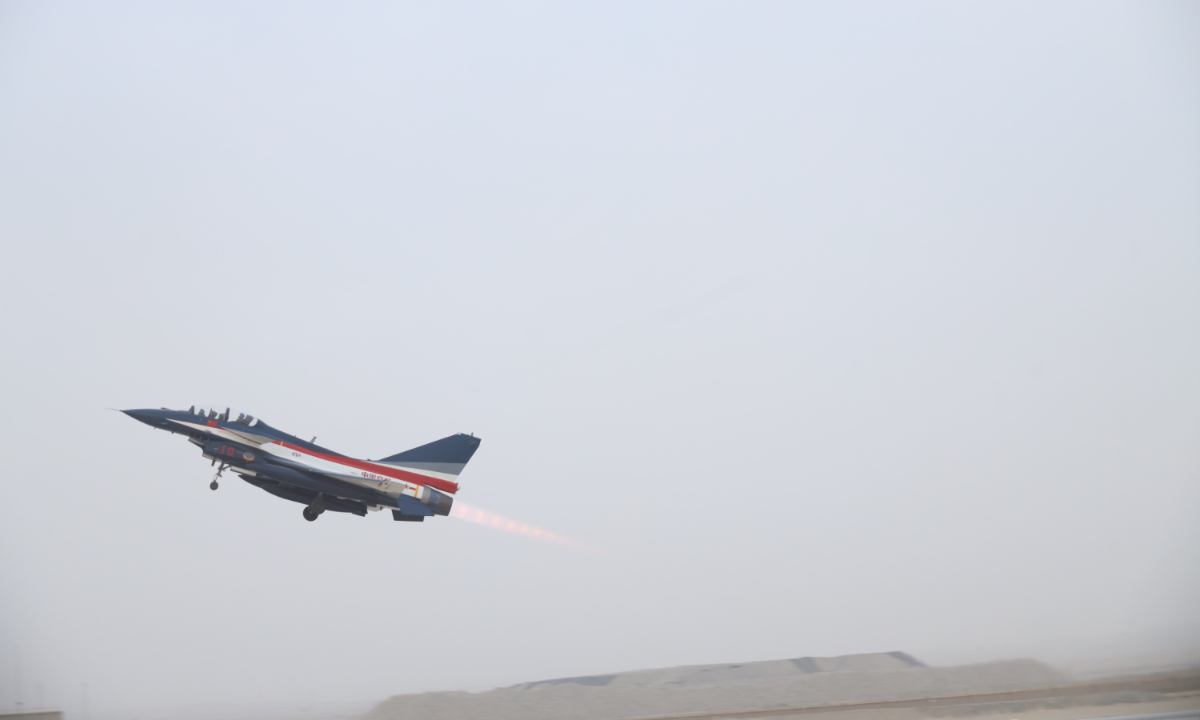BEIJING: Seven J-10 fighter jets from the Chinese People’s Liberation Army (PLA) Air Force Bayi Aerobatic Team took off on Monday morning from an airport in northwestern China for Riyadh, Saudi Arabia, to participate in the World Defense Show 2024, which will be held from February 4 to 8, announced Senior Colonel Xie Peng, a spokesperson of the PLA Air Force.
The team will perform aerobatic displays during the defense show. It is the 10th time the team has flown abroad, showcasing the charm of China’s “Honor Guard in the Blue Sky,” according to Xie.
Force dispatched a YU-20 aerial tanker to accompany the J-10 formation for aerial refueling, Xie noted.
In the more than 60 years since its establishment, the PLA Air Force Bayi Aerobatic Team has flown with the J-5, J-6, JJ-5, J-7EB, J-7GB, J-10, and J-10C, performing more than 700 aerobatic displays for more than 700 delegations from over 170 countries and regions.

Photo: Chinese People’s Liberation Army Air Force
In recent years, the team has continued to go abroad and perform on the world stage, becoming a messenger of peace, culture, and friendship.
In preparation for its first visit to Saudi Arabia, the Bayi Aerobatic Team has conducted on-site inspections of the environment in the airport where it will perform, and carefully arranged the aerobatic maneuvers for this performance after taking both environmental characteristics and flight plans into consideration, the PLA Air Force said in a statement to the Global Times on Monday.
In terms of colored smoke selection, the Bayi Aerobatic Team specifically added green for this performance, as the color represents the national flag of Saudi Arabia and is also a symbol of peace and friendship. The team is confident it will present the most exciting aerobatic performance during the show, showcasing the image and charm of the PLA Air Force’s enterprising spirit and pursuit of excellence on the international stage, according to the statement.
It is also the first time that the PLA Air Force has used the YU-20 aerial tanker for aerial refueling support during the transition process of overseas missions. This allows the Bayi Aerobatic Team to fly directly to Saudi Arabia without the need to stop at foreign airports, the Global Times learned from the PLA Air Force.
Military expert Ma Quan told the Global Times on Monday that using the YU-20 for aerial refueling for the first time to achieve long-distance direct flight for the J-10 performance formation demonstrates three things.
“Firstly, aerial refueling technology is an indispensable key part of modern air forces. It greatly extends the aircraft’s loiter time and enhances the endurance of fighter jets. During this overseas mission, the Bayi Aerobatic Team used aerial refueling, eliminating the need for the aircraft to land at an airport, thus reducing reliance on ground airports. Secondly, the team’s long-distance transition, accompanied by the domestically-produced YU-20 aerial tanker, signifies the maturity of China’s key aerial refueling technology and reflects the achievements of the PLA’s strategic transformation and construction of the Air Force in recent years,” Ma said.
Thirdly, the J-10 demonstration formation’s aerial refueling training demonstrates their dual role as both performers and combatants. The main function of an aerobatic team is to showcase core military capabilities through spectacular flight performances, shaping the military’s image, conveying their spirit, and demonstrating their values.
“The pilots of the Bayi Aerobatic Team are all outstanding pilots selected from combat units. Flying directly from a domestic airport to Riyadh, a journey of several thousand kilometers that requires aerial refueling, reflects the PLA Air Force’s level of practical training,” Ma pointed out.
In a video released by the PLA Air Force, Global Times noted a particular detail: a YU-20 and a demonstration formation of six J-10 jets leave trails of white smoke at an altitude of some 10,000 meters.
Ma explained that this is commonly called “contrails” – a physical phenomenon that usually occurs under specific weather conditions, such as temperatures ranging from minus 30 to 40 C.
In fact, the “white smoke” emitted by the aircraft is not “smoke” but actually condensed water droplets. It is similar to the principle of exhaling hot air in cold winter, forming fog. Due to the large temperature difference and the rapid condensation of water vapor in the hot air, countless visible small water droplets are suspended in the air. The exhaust gas emitted by the aircraft’s engines at an altitude of 10,000 meters, which is high in temperature and contains a large amount of water vapor, condenses into tiny water droplets when it encounters cold air, forming what people see as “smoke,” according to Ma.
“The white smoke trailing behind the aircraft during high-altitude and high-speed flight reflects, to a certain extent, the strong power performance of the aircraft,” Ma stressed.



















